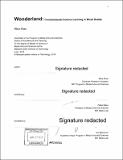| dc.contributor.advisor | Pattie Maes. | en_US |
| dc.contributor.author | Khan, Mina(Cognitive data scientist)Massachusetts Institute of Technology. | en_US |
| dc.contributor.other | Program in Media Arts and Sciences (Massachusetts Institute of Technology) | en_US |
| dc.date.accessioned | 2019-11-12T17:42:26Z | |
| dc.date.available | 2019-11-12T17:42:26Z | |
| dc.date.copyright | 2018 | en_US |
| dc.date.issued | 2018 | en_US |
| dc.identifier.uri | https://hdl.handle.net/1721.1/122896 | |
| dc.description | Thesis: S.M., Massachusetts Institute of Technology, School of Architecture and Planning, Program in Media Arts and Sciences, 2018 | en_US |
| dc.description | Cataloged from PDF version of thesis. | en_US |
| dc.description | Includes bibliographical references (pages 95-99). | en_US |
| dc.description.abstract | Science concepts lie at the heart of our everyday experiences, yet people feel disconnected from science because of the abstract way it is taught in schools. We wanted people to learn science concepts in the real world in playful ways, and used Mixed Reality (MR) to allow people to visualize and play with science concepts in the real world. We focused on Newtonian physics as our first science concept in Wonderland because Newtonian physics is commonly experienced by people in their everyday lives, especially in playful contexts, e.g., when they throw a ball. We created simple Newtonian physics tools, which served as building blocks of Newtonian physics systems to allow learners to build their own Newtonian physics models and puzzles for constructionist learning. We include different types of custom visualizations, e.g., graphs, velocity and acceleration vectors, etc, to allow the users to visualize the underlying physics of objects in scientifically accurate, yet intuitive ways. Our rewinding interface also enables users to play, pause, rewind, replay, speed up and slow down physics so that users can learn from repeated physics experimentation. We created two versions of Wonderland: a Hololens version for an immersive head-worn MR experience, and an ARKit version for a more widely accessible MR experience on iOS devices. Our experiments show that users enjoy solving Newtonian physics puzzles in Wonderland, and find the visuals and simulations helpful in understanding Newtonian physics concepts. We aim to further develop and deploy Wonderland to promote science learning and exploration in the real world. | en_US |
| dc.description.statementofresponsibility | by Mina Khan. | en_US |
| dc.format.extent | 99 pages | en_US |
| dc.language.iso | eng | en_US |
| dc.publisher | Massachusetts Institute of Technology | en_US |
| dc.rights | MIT theses are protected by copyright. They may be viewed, downloaded, or printed from this source but further reproduction or distribution in any format is prohibited without written permission. | en_US |
| dc.rights.uri | http://dspace.mit.edu/handle/1721.1/7582 | en_US |
| dc.subject | Program in Media Arts and Sciences | en_US |
| dc.title | Wonderland : constructionist science learning in mixed reality | en_US |
| dc.title.alternative | Constructionist science learning in mixed reality | en_US |
| dc.type | Thesis | en_US |
| dc.description.degree | S.M. | en_US |
| dc.contributor.department | Program in Media Arts and Sciences (Massachusetts Institute of Technology) | en_US |
| dc.identifier.oclc | 1126790825 | en_US |
| dc.description.collection | S.M. Massachusetts Institute of Technology, School of Architecture and Planning, Program in Media Arts and Sciences | en_US |
| dspace.imported | 2019-11-12T17:42:25Z | en_US |
| mit.thesis.degree | Master | en_US |
| mit.thesis.department | Media | en_US |
